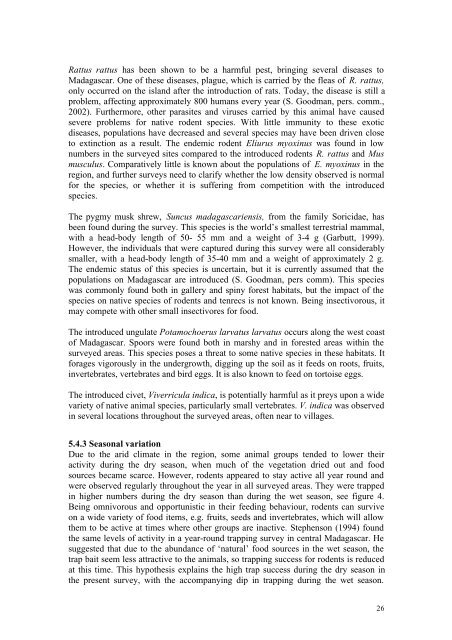The proposed Parc Regional de Belomotse - Frontier-publications ...
The proposed Parc Regional de Belomotse - Frontier-publications ...
The proposed Parc Regional de Belomotse - Frontier-publications ...
You also want an ePaper? Increase the reach of your titles
YUMPU automatically turns print PDFs into web optimized ePapers that Google loves.
Rattus rattus has been shown to be a harmful pest, bringing several diseases to<br />
Madagascar. One of these diseases, plague, which is carried by the fleas of R. rattus,<br />
only occurred on the island after the introduction of rats. Today, the disease is still a<br />
problem, affecting approximately 800 humans every year (S. Goodman, pers. comm.,<br />
2002). Furthermore, other parasites and viruses carried by this animal have caused<br />
severe problems for native ro<strong>de</strong>nt species. With little immunity to these exotic<br />
diseases, populations have <strong>de</strong>creased and several species may have been driven close<br />
to extinction as a result. <strong>The</strong> en<strong>de</strong>mic ro<strong>de</strong>nt Eliurus myoxinus was found in low<br />
numbers in the surveyed sites compared to the introduced ro<strong>de</strong>nts R. rattus and Mus<br />
musculus. Comparatively little is known about the populations of E. myoxinus in the<br />
region, and further surveys need to clarify whether the low <strong>de</strong>nsity observed is normal<br />
for the species, or whether it is suffering from competition with the introduced<br />
species.<br />
<strong>The</strong> pygmy musk shrew, Suncus madagascariensis, from the family Soricidae, has<br />
been found during the survey. This species is the world’s smallest terrestrial mammal,<br />
with a head-body length of 50- 55 mm and a weight of 3-4 g (Garbutt, 1999).<br />
However, the individuals that were captured during this survey were all consi<strong>de</strong>rably<br />
smaller, with a head-body length of 35-40 mm and a weight of approximately 2 g.<br />
<strong>The</strong> en<strong>de</strong>mic status of this species is uncertain, but it is currently assumed that the<br />
populations on Madagascar are introduced (S. Goodman, pers comm). This species<br />
was commonly found both in gallery and spiny forest habitats, but the impact of the<br />
species on native species of ro<strong>de</strong>nts and tenrecs is not known. Being insectivorous, it<br />
may compete with other small insectivores for food.<br />
<strong>The</strong> introduced ungulate Potamochoerus larvatus larvatus occurs along the west coast<br />
of Madagascar. Spoors were found both in marshy and in forested areas within the<br />
surveyed areas. This species poses a threat to some native species in these habitats. It<br />
forages vigorously in the un<strong>de</strong>rgrowth, digging up the soil as it feeds on roots, fruits,<br />
invertebrates, vertebrates and bird eggs. It is also known to feed on tortoise eggs.<br />
<strong>The</strong> introduced civet, Viverricula indica, is potentially harmful as it preys upon a wi<strong>de</strong><br />
variety of native animal species, particularly small vertebrates. V. indica was observed<br />
in several locations throughout the surveyed areas, often near to villages.<br />
5.4.3 Seasonal variation<br />
Due to the arid climate in the region, some animal groups ten<strong>de</strong>d to lower their<br />
activity during the dry season, when much of the vegetation dried out and food<br />
sources became scarce. However, ro<strong>de</strong>nts appeared to stay active all year round and<br />
were observed regularly throughout the year in all surveyed areas. <strong>The</strong>y were trapped<br />
in higher numbers during the dry season than during the wet season, see figure 4.<br />
Being omnivorous and opportunistic in their feeding behaviour, ro<strong>de</strong>nts can survive<br />
on a wi<strong>de</strong> variety of food items, e.g. fruits, seeds and invertebrates, which will allow<br />
them to be active at times where other groups are inactive. Stephenson (1994) found<br />
the same levels of activity in a year-round trapping survey in central Madagascar. He<br />
suggested that due to the abundance of ‘natural’ food sources in the wet season, the<br />
trap bait seem less attractive to the animals, so trapping success for ro<strong>de</strong>nts is reduced<br />
at this time. This hypothesis explains the high trap success during the dry season in<br />
the present survey, with the accompanying dip in trapping during the wet season.<br />
26
















